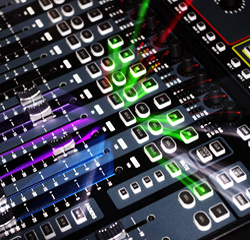
Along the user experience lines, a hallmark of the SSL Live console is onboard multi-gesture touch screens (one of which is 19 inches while the other is 7.5 inches), along with a dedicated system monitor screen that can be mounted on an optional arm on either side of the console.
The monitor screen really comes in handy in keeping track of the 144 fully processed and 48 dry mix channels, and the 32 x 36 output matrix.
A cool add-on is the SSL Live-Recorder option, a single rack space device that connects via MADI and records 64 tracks at 96 kHz continuously from the console’s input stage. The unit can play back audio for a virtual sound check, helping us get set up in a venue quicker.
The Allen & Heath Qu Series combines a lot of the great features of the larger GLD and iLive mixing systems—plus some unique facets—into a more compact package with a very well considered control surface. I particularly like the multi-track recording options, including the ability to stream all input channels and the main LR to a computer DAW.
And in addition to streaming audio, Qu consoles have integrated multi-track USB recorders, providing 18 channels of recording and playback straight to and from a USB hard drive. And, 2-track recording can be accomplished via USB as well.
We’ve also recently seen consoles integrate further with personal monitor mixers, and Allen & Heath does this with the ME1, which is capable of mixing up to 40 inputs. This takes some heat off of engineers by allowing performers to tailor their own mixes to taste for headphones, IEMs, or stage wedges.
DiGiCo consoles are always well-considered, in many ways. Since it was introduced, I’ve paid particular attention to the compact SD11, which provides a ton of capabilities normally found in larger consoles. This includes 32 input channels (including 8 “flexi” stereo or mono channels), 12 flexi stereo or mono buses, LR or LCR buses and an 8 x 8 output matrix, all in a compact rack-mountable unit and topped by a large 15-inch touch screen that’s very readable at a glance.
A theme of our focus is better and easier recording capability, and that continues here. The DiGiGrid MGB (coaxial link) and MGO (optical link) interfaces foster plugging in a MADI device to Waves SoundGrid for recording, processing and playback of up to 128 audio channels. It can even record to two computers simultaneously, great for a “no brainer” backup.
